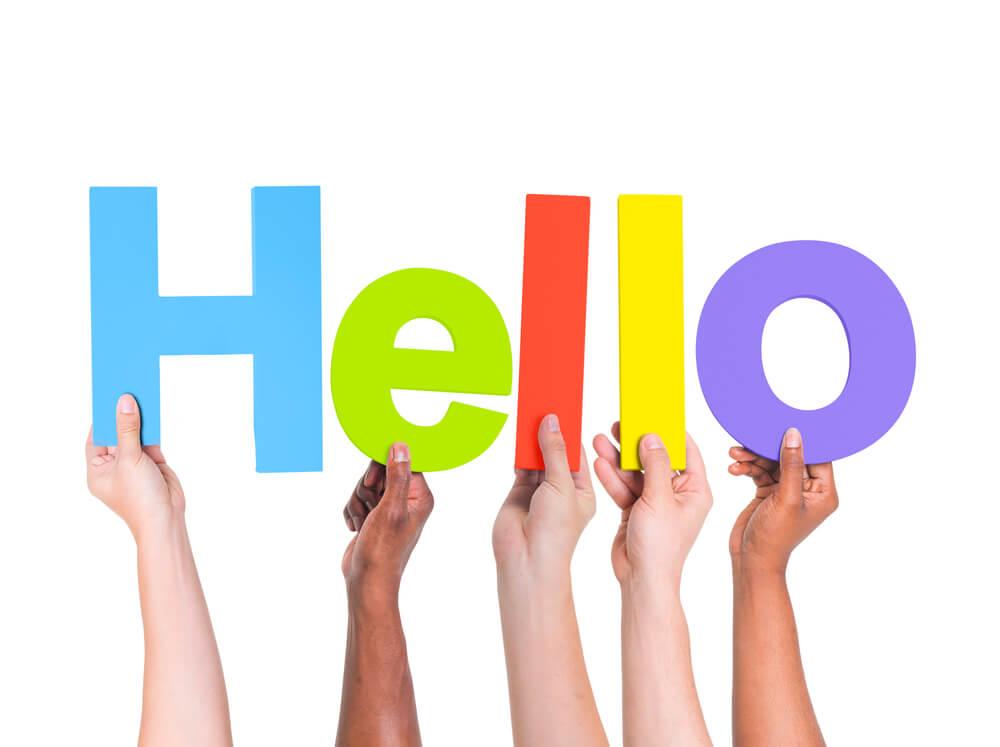It is interesting to say hello in different languages. “Hello” is unquestionably the most utilized word in English communication. A common aspect of our daily greeting is the word “hello.” However, that is not the case with any language save English. There is a word in every language equivalent to “hi” or “hello” in English but unique in its meaning and importance in everyday conversation. Eventually, you’ll need to find a new way to welcome people when you run out of variations on “Hello,” and you’ll likely turn to Google for suggestions. How cool would it be to learn to say “Hello” in various languages?

Hello in different languages – Its Importance
There is a word in every language that has the power to instantly unite strangers in a shared experience of laughter and goodwill. How a simple “hello” can make a stranger smile, or cause one person to stop what they’re doing to give another their full attention, is nothing short of magical. It has a variety of pronunciations and looks depending on the language it’s being used in. A wave, a nod, a handshake, or a bow convey the same meaning: acknowledgment of another person.
A simple “hello!” can begin a lifelong friendship, much like the first step in learning a new language. In this article, we’ll examine 12 different phrases for doing so. So there you have it: 12 ways to make friends out of strangers, 12 techniques to charm people all over the world from Madrid to Calcutta.
Mother Language Day.
To “promote cultural diversity and multilingualism,” the first International Mother Language Day was held in February of 2000. Now, eighteen years later, you can celebrate not only your native tongue and culture but also those of people worldwide.
The purpose of celebrating International Mother Language Day is to raise awareness about the need to preserve and teach languages from throughout the world and learn about and appreciate the cultures that developed such languages.
Global languages
Languages are crucial to society because they facilitate interaction and self-expression among individuals. It is estimated that there are currently 6909 spoken languages in the world, albeit this may be an underestimate because “linguists occasionally argue what different languages are and what are dialects of the same language.”
Fewer than a thousand languages are taught formally and unofficially, and even fewer are utilized online. Thus, it is predicted that more than half of the 6909 languages will be extinct within a few generations.
Methods of Honoring One’s Native Tongue on the Day Devoted to Its Preservation
- Visit language schools in London, Eastbourne, or Dublin to improve your English skills.
- Acquire a foreign phrase or term.
- Share a new term from your native tongue with a fellow student.
- If you are interested to learn how to pronounce a term, you should probably ask someone who speaks a foreign language.
Or, in honour of the day, why not try to say hello in different languages?
Hello in Different Languages
Learn how to greet people and say hello in different languages. with this handy reference. Let’s check out some alternative greetings to “Hello” in other languages.
How to Say “Hello” in a Variety of Languages, Pronounced!
The universal greeting in English is “hello.”
The most spoken language in 2nd number in the world is also an excellent language for solitary travellers to learn so they can communicate with locals in their destination country. Canada, the United Kingdom, the United States, Australia, and New Zealand recognize English as their official language.
Wales: shwmae
Shwmae, which means “Hello, how are things?” in Welsh, is another problematic method of saying hello in different languages. Therefore, it serves as a greeting and inquiry into the recipient’s health. You can use this informal greeting in North Wales; the locals pronounce it “shuh-my.”
Ciao in Italian:
Italy, in the south-central part of Europe, is the primary user of the greeting ciao. It’s an informal greeting that works for both hellos and goodbyes. It’s a simple approach to communicating with people of diverse cultures. The term has its roots in a Venetian phrase that translates to “I am your slave,” while its modern usage more closely resembles “I am at your service.” It’s a term of endearment used solely among the closest friends and familiars. The word “Salve” is used as a polite greeting in Italian. Salve is the greeting in Latin, the language of the ancient Roman Empire. Salve is used as a greeting when there is just one person present, but “Salvete” is used when there are more than two persons.
Hola in Spanish
When people are asked how to say “hi” in a foreign language, “hola” (Spanish for “hello”) is often one of the most frequently cited (oh-la). Hola can be used as a pleasant or formal greeting, depending on the context. Literally, “Hello” is “Hola” in Spanish. There are alternative Spanish words that mean “what’s up” or “what’s going on” if you wish to use them in a casual setting. How’s the music scene in your area? Etc.
Ola in Portugal
The Portuguese language is spoken in Portugal and Brazil. As a native tongue, it is only spoken now in a handful of locations, including Angola, Mozambique, Cape Verde, Sao Tome, and Macau. The Philippines are also a great place to trace your linguistic roots.
Yassas in Greek
The standard Greek greeting is “yassas.” Yassou is a common way for Greeks to express their warmth and informality with one another in conversation. So, yassou is a more informal greeting, while yassas is more formal. The word ya, an abbreviation of yassou/yassas, may also be used informally. The Greek counterpart of “hello” or “hey” is not appropriate for use in more formal situations.
Anyeong haseyo in Korean.
You have probably heard this previously in a Korean chat (anyeong haseyo). Because it’s the universal morning, afternoon, and nighttime welcome in Korea. They also have options besides anyeong haseyo, although they rarely use them.
Greeting almost anyone with anyeong haseyo is a breeze. It’s suitable for usage with both young and older people. It’s an excellent way of saying, “please feel well.”
Bonjour in French
Although it is most common in France, the French language is spoken worldwide. You will be understood in Quebec and the rest of Canada, in addition to Belgium, Switzerland, Morocco, Tunisia, and Algeria. In addition to France and Switzerland, Getting a phrasebook will help you navigate the language’s intricate grammar.
A Germanic “Hallo”
Simply saying hello! Greetings in German are thus concluded. It is a simple and informal communication technique with people of other languages. Use it as a standard German greeting for close friends and relatives. Nonetheless, Guten Tag is the correct greeting to use in a business setting. You’ll also hear these greetings used in Austria and Switzerland.
(Ni hao) in traditional Chinese
The most common Chinese greeting is ni hao (nee how). Hello, can be expressed simply by saying “you ok/good,” which translates to “you good” in English. The difference between the two words can be heard in the tone used to pronounce them in Chinese. Knowing that a single word or syllable pronounced in various distinct techniques can thus convey substantially varied notions is essential when learning to say hello in other languages like Chinese. The informal “n” (n ho) is replaced by the formal (ni hao) when politeness is required, for example.
नमस्ते (Namaste) in Hindi
You can get away with only saying “Namaste” to everyone you meet on the Indian subcontinent. Since there is no idea of time in Hindi greetings, you can use this one whenever you like. You can use it to start or end conversations with anyone, regardless of age or social status.
The Sanskrit phrase namaste combines the meanings of “bow” and “to you” (in this case). Using the phrase “Namaste” as a welcome shows deference and modesty. By doing so, you recognize the other person’s existence and his full humanity. Namaste has deep spiritual underpinnings; it reminds us of the life energy, the “god-in-me,” that resides in every individual we meet.
A little nod of the head complements the expression. The praying position involves bringing both palms together in front of the chest. When you say the word “namaste,” bow your head ever-so-slightly. The term “namaste” describes this salutation.
Hello in Arabic is Marhaba
Place of Use The Arabic language is spoken in different parts of North Africa and the Middle East. This Arabic expression means “hell” and is widely used in the following countries: Algeria, Bahrain, Iraq, Israel, Chad, Egypt, Eritrea, Jordan, Kuwait, Lebanon, Libya, Oman, Palestine, Qatar, Saudi Arabia, Mauritania, Morocco, Syria, Tunisia, United Arab Emirates, Western Sahara, and Yemen.
Bună ziua in Roman
Are you interested in learning how to say “hi” in Romanian? Wish someone a happy new year with Bună Ziua! Romanian words can be particularly challenging to pronounce, and there are many formal and informal ways to say “hi” and “goodbye” to someone. For instance, “Buna” or “Salut” can be used in casual settings, whereas “Buntă Ziua” is reserved for more official occasions.
How to Say Hello Formally or Casually in Different Situations
Consider the difference between how you greet your friends and how you greet their parents. A more traditional form of greeting is appropriate for addressing somebody you don’t know well or who are significantly older than you. Business and other formal greetings are appropriate in most retail and dining establishments to say hello in different languages. A decent rule of thumb is to wait until someone makes the first casual conversational move before responding in kind.
Tune in to the conversations going on around you. Whether a phrase is formal or informal depends on factors such as language and culture. After some time has passed and you’ve gotten to know someone well, you may notice that they begin to use more everyday greetings. Use a polite greeting whenever possible.
Conclusion
These are just a few alternatives to the standard hi in different languages.” and “hello in different languages. that you can use to greet others, but you are free to get quite creative with your greetings. Greeting someone warmly can set the tone for a pleasant interaction. In addition to mastering the basics of greetings in various tongues, you should familiarise yourself with the idiomatic and colloquial ways to say “hello” in your language.





